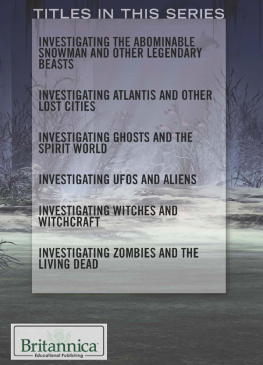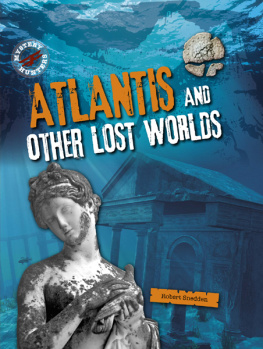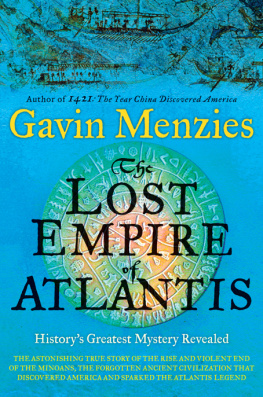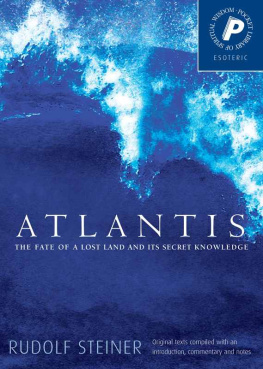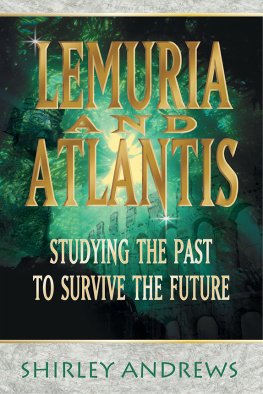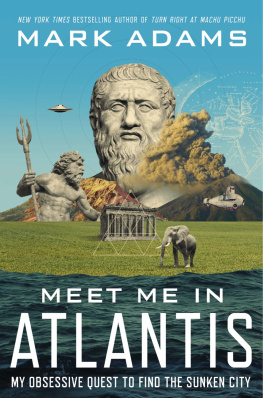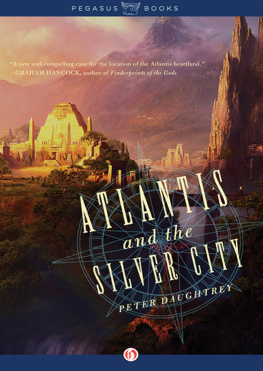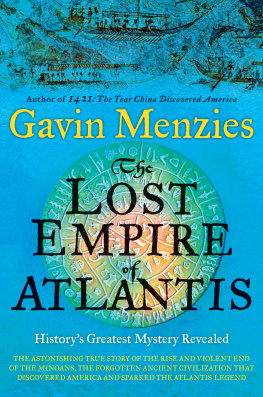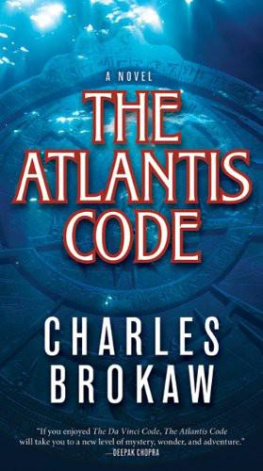
Published in 2015 by Britannica Educational Publishing (a trademark of Encyclopdia Britannica, Inc.) in association with The Rosen Publishing Group, Inc.
29 East 21st Street, New York, NY 10010
Copyright 2015 The Rosen Publishing Group, Inc., and Encyclopdia Britannica, Inc. Encyclopaedia Britannica, Britannica, and the Thistle logo are registered trademarks of Encyclopdia Britannica, Inc. All rights reserved.
Distributed exclusively by Rosen Publishing.
To see additional Britannica Educational Publishing titles, go to rosenpublishing.com.
First Edition
Britannica Educational Publishing
J. E. Luebering: Director, Core Reference Group
Anthony L. Green: Editor, Comptons by Britannica
Rosen Publishing
Hope Lourie Killcoyne: Executive Editor
Jacob R. Steinberg: Editor
Nelson S: Art Director
Nicole Russo: Designer
Cindy Reiman: Photography Manager
Cataloging-in-Publication Data
Wolny, Philip.
Investigating Atlantis and other lost cities/Philip Wolny.
pages cm.(Understanding the paranormal)
Includes bibliographical references and index.
ISBN 978-1-62275-862-3 (eBook)
1. Atlantis (Legendary place)Juvenile literature. 2. Extinct citiesJuvenile literature. 3. ArchaeologyJuvenile literature. I. Title.
GN751.W65 2015
001.94dc23
2014023244
Photo credits: Cover, p. 1 Cindi L/Shutterstock.com; pp. 45 Fortean/TopFoto/The Image Works; pp. 7, 17, 25 De Agostini Picture Library/Getty Images; p. 9 swilmor/iStock/Thinkstock; p. 10 Photos.com/Thinkstock; p. 12 1997; AISA, Archivo Iconogrfico, Barcelona, Espaa; p. 13 Culture Club/Hulton Archive/Getty Images; p. 15 C. Reyes/Shostal Associates; p. 19 The Bridgeman Art Library/Getty Images; p. 21 Hulton Archive/Getty Images; p. 22 Getty Research Institute/Photo Researchers, Inc.; p. 26 Print Collector/Hulton Archive/Getty Images; p. 29 Rachid Dahnoun/Getty Images; p. 31 De Agostini/Getty Images; p. 34 Charles Walker/Topfoto/The Image Works; p. 35 Jeffrey Alford/Asia Access; p. 37 Beuna Vista/courtesy Everett Collection; p. 39 photo by ZUMA Archive/ZUMA Press 2006 by ZUMA Archive; p. 41 Erica Brough/Gainsville Sun/Landov; interior pages background images iStockphoto.com/Kivilvim Pinar, iStockphoto.com/mitja2.
CONTENTS
L egends of lost places or peoples have captured the imaginations of many different civilizations throughout history. Such tales have existed as long as humans have told each other stories.
One of the most famous and long-lived legends has been that of Atlantis. Atlantis first appeared in the classical Greek writings of the famous philosopher and mathematician Plato. Atlantis was said to be a once powerful island nation that was completely destroyed by a great disasterone that submerged it beneath the ocean.
Many civilizations and cultures share such stories. Some of these tales were inspired by real places or events. Others were merely born from the vivid imaginations of storytellers. Lost cities of gold, ideal or magical places, and other mysterious sites have inspired exploration throughout the centuries. They have also been common subjects of literature and other media such as movies and television.
It is vital to investigate the origins of these stories, how they relate to reality, and also what makes them so popular with different cultures and peoples. By doing so, one can dive deep into the mysteries of Atlantis and other lost cities and begin to understand them.

The mythical lost civilization of Atlantis has inspired legends and speculation for centuries. It is often depicted as seen here: abandoned and submerged beneath the ocean, with architecture resembling that of ancient Greece or Rome.
O ne of the first people to describe the legend of Atlantis in detail was Plato. Plato was one of the most important thinkers of ancient Greece. Around 360 BCE , Plato wrote Timaeus. This dialogue of Platos mostly consists of a monologuea kind of dramatic story or speech told by a sole speaker or narrator. Timaeus, the speaker, tells other characters, among them the famous philosopher Socrates, about the nature of the world and humanity.
Before Timaeuss monologue begins, however, another character named Critias first tells a tale about his fellow Athenian statesman, Solon. While traveling to Egypt, an Egyptian priest had told Solon of the battle between ancient Athens and another power. Beyond the Strait of Gibraltar, which connects the Mediterranean Sea with the Atlantic Ocean, there lay a large island, larger than Libya and Asia put together. This was the island of Atlantis.

Pictured here is a marble bust of Plato, the ancient Greek philosopher, writer, and mathematician whose mentions of Atlantis in his writings still intrigue readers and historians today.
Critias added that Atlantis had rule over the whole island and several others, and over parts of the continent... The men of Atlantis had subjected the parts of Libya within the Pillars of Heracles [an ancient name for the Strait of Gibraltar] as far as Egypt, and of Europe as far as Tyrrhenia [a region of central Italy]. It was the leadership of Athens, the powerful city-state of ancient Greece, that defeated the Atlanteans when their kings tried to conquer more of the world.
PLATO, PHILOSOPHER AND THINKER
Platos ideas and writings on philosophy, science, and math helped lay the foundations of Western civilization. Plato wrote many dialogues, stories in which characters explore moral or philosophical issues through conversation. It was a format invented by his teacher and mentor, Socrates. Along with Platos student, Aristotle, the three are considered the greatest Western thinkers of their era.
Plato opened a school, the Academy at Athens, in about 387 BCE , to provide lessons in philosophy, law, and scientific researchprimarily mathematics. Plato grew up during the decades of conflict with Sparta and other city-states. This conflict, coupled with the forced suicide of his teacher Socrates for political reasons in 399 BCE , is believed to have influenced some of his dialogues, including the ones involving Atlantis.

The Rock of Gibraltar, located on the British territory also called Gibraltar, rises above the Strait of Gibraltar, which separates the Mediterranean Sea from the Atlantic Ocean to the west. It is beyond this strait where Atlantis was most famously rumored to be.
CRITIAS
Plato returns to Atlantis in much bolder detail in his next dialogue, Critias, named after the main narrator. Critias recounts that the Greek god of the sea, Poseidon, married a mortal woman. Their descendants came to rule over the island of Atlantis, whose unique geography was Poseidons creation. Rings of land surrounded its center, and each ring was surrounded by a body of water. A canal ran through the center of this land to connect each ring to the sea. The island at the middle contained the capital of Atlantis, the city itself was said to be 11 miles (18 kilometers) wide.

